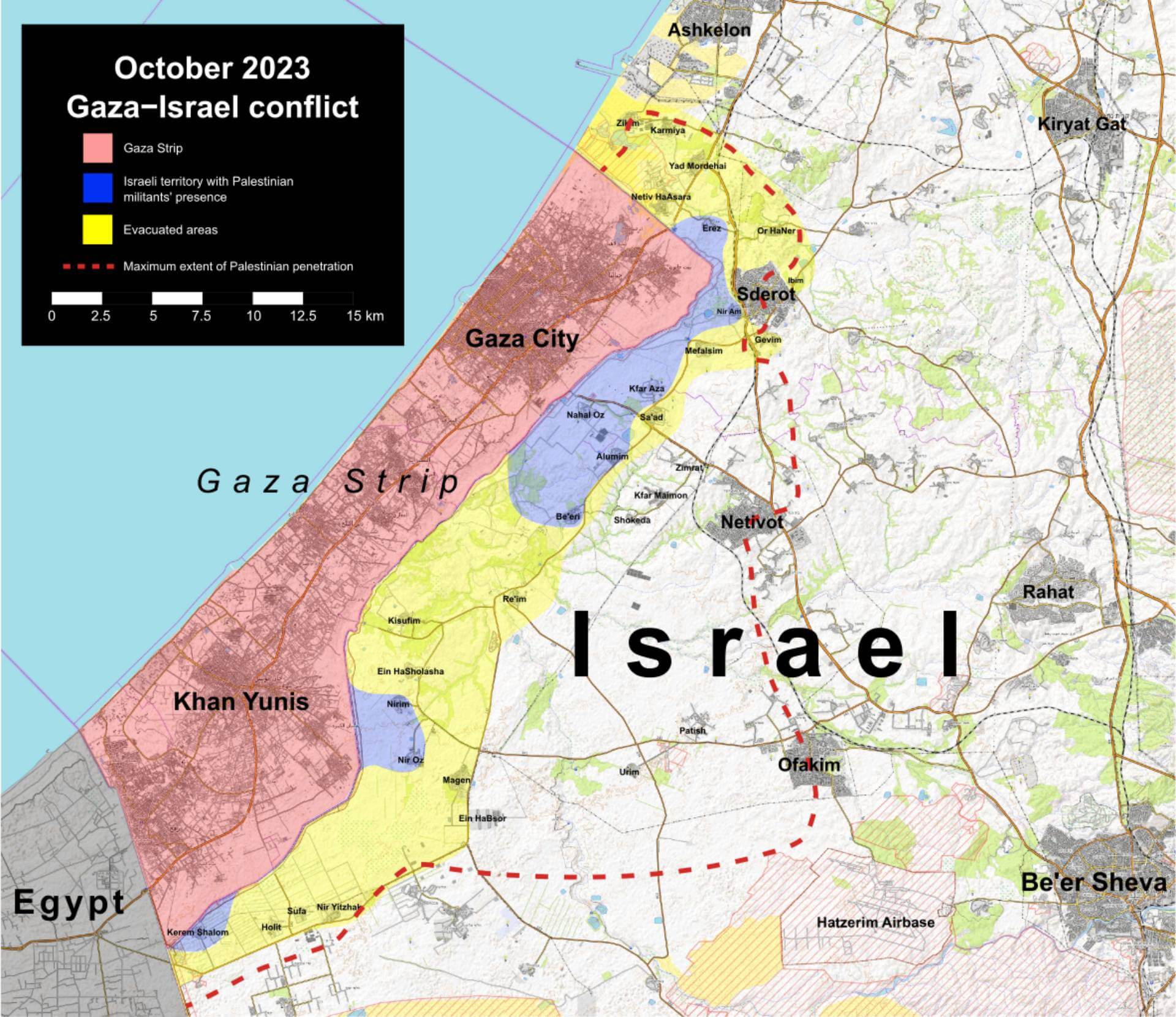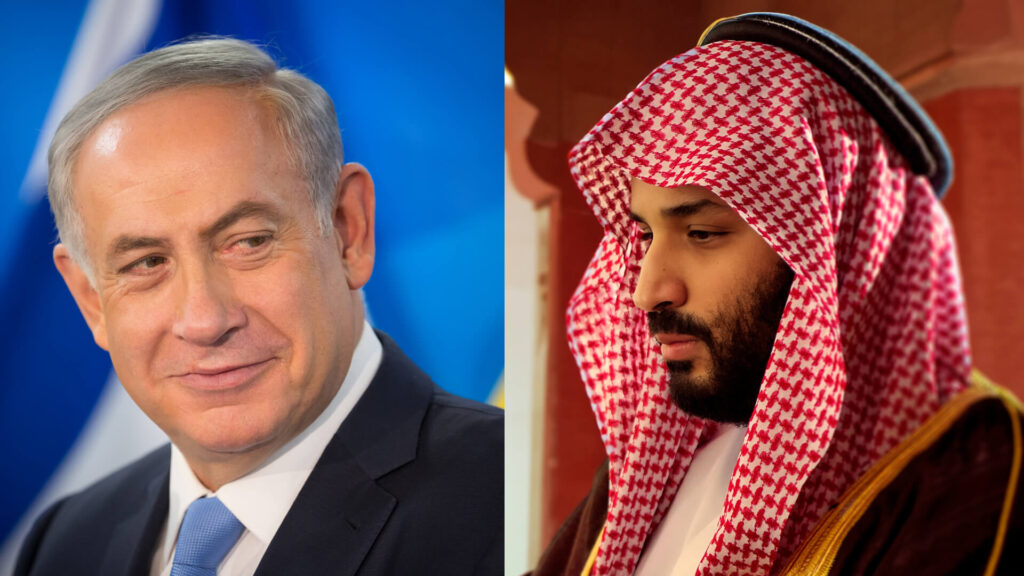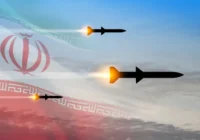Early October 7, the Gaza-based Hamas organization launched an unprecedented air, land and sea assault on Israel. The terrorist attack came as Israelis were celebrating the conclusion of Sukkot, or the “Festival of Booths,” and it took the Israelis by surprise. The attack also coincided with this week’s 50th anniversary of the Yom Kippur War.
The struggle between Israeli forces and militants of Hamas and Palestinian Islamic Jihad (PIJ) is ongoing. As of about midnight, October 8, reports indicate more than 800 Israeli deaths and thousands wounded, whether in the Israeli towns bordering Gaza that have come under attack or elsewhere due to rocket barrages. Especially noteworthy, Hamas combatants have taken more than one hundred Israelis, including women, elderly and children, hostage.
The ground combat and massive Israeli air attacks on Gaza have led to more than 576 Palestinian dead and hundreds more wounded, according to Al Jazeera.
It won’t be over quickly
It is much too early to make predictions about the war’s outcome, but some observations can be made even as the combat rages into the fourth day.
Israel and Hamas have been engaged in armed conflict over the past dozen years on some half-dozen occasions, not all of which were classified as wars, per se. Most ended in days or weeks, with the most intense fighting occurring at the outset and then trailing off. In almost all cases, Egypt served as the intermediary between the sides in negotiating eventual ceasefires.
None of those previous confrontations, however, match the intensity, scale and audacity of this most recent attack. Moreover, the harshness of Israeli Prime Minister Benjamin Netanyahu’s statement shortly after the initial assaults that “Israel is at war,” his vow to “turn Hamas strongholds into rubble” and his subsequent mobilization of Israeli Defense Forces (IDF) reserves suggest we should not expect a quick end to this conflict.
Furthermore, Iran and its Islamic Revolutionary Guard Corps have been aiding and training Hamas for years in stockpiling rockets, weapons and other armaments for the long haul. In scale, this conflict shows all the signs of exceeding the viciousness, destruction and death of all prior IDF–Hamas confrontations and even the Second Intifada of the early 2000s. That latter conflict lasted nearly five years and took the lives of some 3,000 Palestinians and 1,000 Israelis, as well as tens of foreigners.
The Iranian hand and the Saudi-Israel normalization factor
Given the lopsided outcome of previous wars and violence, in which Palestinian losses far exceeded Israeli losses, what might have motivated Hamas to launch an attack of this magnitude?
Hamas has said it launched the war due to ongoing abuses of Palestinians by Israel, the continuing Israeli occupation of Palestine and the blockade of Gaza, none of which has changed much over the course of the last few years. Moreover, most of the Israeli–Palestinian confrontations in the last two years have been in the West Bank and Jerusalem, not Gaza. So, we would be wise to take Hamas’s declared purpose for this action with a heavy dose of skepticism.
The balance of forces has changed somewhat due to the aforementioned Iranian (and potentially other) arms flows to Hamas. Nevertheless, Israel’s armed forces are a modern, highly sophisticated, first-world military force with an overwhelming advantage in every category of warfighting. Hamas is a well-armed resistance force without an air force or navy, though it’s creatively utilized boats and gliders as part of this recent assault. Important as well, Israel is backed by the considerable arsenal of the United States, though that has been depleted significantly due to US support of Ukraine in its war against the Russian invasion. Nevertheless, Israel is more than capable to carry the fight to Hamas for a considerable time.
What has changed, however, is the political dynamic. The US, Israel and Saudi Arabia are engaged in intense negotiations that would provide for normalization of relations between Saudi Arabia and Israel and new security arrangements between the US and the Kingdom.
That sort of deal presents an alignment of forces in the region clearly unfavorable to Iran and its security and economic interests. It is logical to conclude it would want and seek to torpedo a Saudi-Israel normalization pact, and especially one involving the United States. What could be better than re-igniting yet another all-out conflict between the Palestinians and Israelis?
The Wall Street Journal reported that the plan for the massive attack was hatched in Tehran, which only recently gave the green light to its Hamas proxies to advance on Israel. Iran’s role is undeniable.
Where was Israel’s intelligence?
This very distinct and likely possibility poses another question. How did Israeli intelligence, and US intelligence, too, miss the warning signs?
One report indicates that Hezbollah, the Iran-backed, Lebanon-based terrorist organization, had recently warned the United Nations Interim Force in Lebanon to remain on its bases along the Israel-Lebanon border in the weeks ahead. Were there other signs Israeli and American intelligence missed?
The Americans, for their part, have turned the lion’s share of their intelligence resources and assets toward Russia and China and away from the Middle East over recent years. Hamas, which hasn’t threatened the US or US assets, is a low priority for the US. But not so for Israel, which keeps a close and wary eye on Hamas and Iran. It possesses formidable signals, cyber and human intelligence on the Palestinians, especially on Hamas and PIJ. Likewise on Iran. It’s surprising that they did not detect signs of such a massive, multi-pronged invasion force into Israeli territory.
It’s even more surprising given the Israeli experience in the Yom Kippur War. At the outset of that war, Egyptian and Syrian forces caught Israel by surprise and inflicted immense damage on the Jewish state and its forces before they could regroup and mount what was ultimately a successful counterattack.
Go for broke, or try another interim solution?
US President Joe Biden vehemently condemned the attack and has promised to support Israel. Other Western governments have made similar statements. Russia, though unlikely to have been directly involved, cannot help but rejoice over it and the prospect of yet another burden imposed on US military resources. Russia can be expected to exploit this rare advantage. If the conflict is prolonged, the US will be hard pressed to meet all its commitments to both Ukraine and Israel.
In addition, Congressional opponents of Biden’s recent new funding request for Ukraine will likely stiffen their resistance, arguing that Israel ought to be a higher priority for America’s limited resources.
For Israel, the most important consideration is what to do next and how to bring this conflict to an end. To be sure, there will be no such talk of ending this until Israel inflicts severe and devastating damage on Hamas, its leadership and organization — another reason why this conflict is unlikely to end soon.
The kernel of the problem is Hamas’s vice grip on Gaza, including infrastructure, security, economy, fuel, schools, mosques, public services, etc. As some have argued, short of an outright invasion and re-occupation of the Palestinian enclave, it’s hard to conceive of Israel totally uprooting Hamas, which has been the governing authority in Gaza since 2007.
Israeli leaders and the IDF are well aware of the challenge of invading Gaza. It would be costly and exponentially more deadly. Israel’s last major incursion into Gaza in 2014, known as Operation Protective Edge, met with limited success and proved highly costly in terms of Israeli lives and, especially, Palestinian lives. Any long-term occupation would involve almost nonstop house-to-house urban combat in one of the world’s most densely populated areas over a sustained period of time, making such an approach almost out of the question. It would levy an insupportable demand on the IDF and on Israeli financial resources. Would Israel really want to take on the Herculean task of governing a recalcitrant and rebellious population?
What may be possible is a short and very intense incursion to capture or eliminate Hamas’s most important leaders, especially in the armed wing. Moreover, Israel would want to inflict irreparable damage to the Hamas military and political organization and terrorist infrastructure. That may still be too tall a task, but infinitely more manageable than any long-term occupation.
The Israelis could turn to the Palestinian Authority and its president, Mahmoud Abbas, to run an Israeli-tamed Gaza. But neither are any more liked or regarded in Gaza than they are in the West Bank. They lack the competence and administrative wherewithal to effectively govern Gaza and would have to turn to the Israeli government for added funding to even start. Even so, while Abbas may publicly sound verbal support for the people of Gaza and their rights, he’s likely privately applauding every blow Israel strikes against its political foe, Hamas.
There is one major caveat to all of this, the Israeli hostages. Hamas likely took them specifically to forestall an invasion of Gaza by the IDF. We should not be surprised if they are used as human shields to protect facilities in Gaza and, more important, Hamas assets. Hamas is above all a terrorist organization and willing to employ all means, including the lives of innocent hostages, to ruthlessly advance its goals.
Israel has paid a high price in the past to retrieve Israelis, and even the remains of Israelis, held by terrorists. In 2006, a Palestinian special forces squad infiltrated Israel, captured Israeli IDF Corporal Gilad Shalit and took him back to Gaza. He was held there until 2011 when Israel agreed to release more than a thousand mostly Palestinian prisoners — nearly 300 of whom were serving life sentences – in exchange for Shalit’s freedom. Many criticized Netanyahu for the lopsided exchange. But in the minds of most Israelis, as one ranking Israeli official at the time shared with me, it was a necessary bargain to regain the freedom of one of their own. The value Israel places on human life is a vulnerability of the Israelis with which Hamas is well acquainted and, therefore, can be expected to use to extract major concessions the Israelis will be at pains to accept.
For now, however, the capture of so many Israeli hostages presents a major challenge to Israel and a significant constraint on its military and political options. And it’s likely to prove a highly emotional and divisive issue in an already-divided Israeli body politic.
This Gaza war really is different.
[Anton Schauble edited this piece.]
The views expressed in this article are the author’s own and do not necessarily reflect Fair Observer’s editorial policy.
Support Fair Observer
We rely on your support for our independence, diversity and quality.
For more than 10 years, Fair Observer has been free, fair and independent. No billionaire owns us, no advertisers control us. We are a reader-supported nonprofit. Unlike many other publications, we keep our content free for readers regardless of where they live or whether they can afford to pay. We have no paywalls and no ads.
In the post-truth era of fake news, echo chambers and filter bubbles, we publish a plurality of perspectives from around the world. Anyone can publish with us, but everyone goes through a rigorous editorial process. So, you get fact-checked, well-reasoned content instead of noise.
We publish 2,500+ voices from 90+ countries. We also conduct education and training programs
on subjects ranging from digital media and journalism to writing and critical thinking. This
doesn’t come cheap. Servers, editors, trainers and web developers cost
money.
Please consider supporting us on a regular basis as a recurring donor or a
sustaining member.
Will you support FO’s journalism?
We rely on your support for our independence, diversity and quality.








Comment